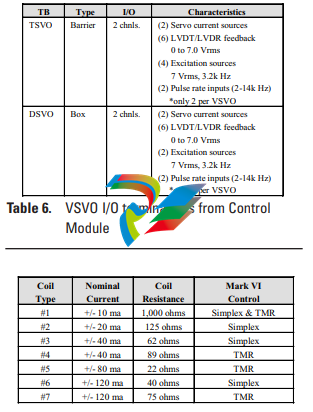
GESPEEDTRONIC™ Mark VI Turbine Control System
series with the internal K25P synch permissive
relay and the K25 auto synch relay via the
TTUR. Feedback of the actual breaker closing
time is provided by a 52G/a contact from the
generator breaker (not an auxiliary relay) to
update the database. An internal K25A synch
check relay is provided on the TTUR; however,
the backup phase / slip calculation for this relay
is performed in the Backup Protection Module
or via an external backup synch check relay.
Manual synchronizing is available from an operator station on the network or from a synchroscope.
Shaft Voltage and Current Monitor. Voltage can
build up across the oil film of bearings until a
discharge occurs. Repeated discharge and arcing can cause a pitted and roughened bearing
surface that will eventually fail through accelerated mechanical wear. The VTUR / TTUR can
continuously monitor the shaft-to- ground voltage and current, and alarm at excessive levels.
Test circuits are provided to check the alarm
functions and the continuity of wiring to the
brush assembly that is mounted between the
turbine and the generator.
F
Flame Detection. The existence of flame either
can be calculated from turbine parameters that
are already being monitored or from a direct
interface to Reuter Stokes or Honeywell-type
flame detectors. These detectors monitor the
flame in the combustion chamber by detecting
UV radiation emitted by the flame. The Reuter
Stokes detectors produce a 4-20ma input. For
Honeywell flame scanners, the Mark VI supplies
the 335Vdc excitation and the VTUR / TRPG
monitors the pulses of current being generated.
This determines if carbon buildup or other
contaminates on the scanner window are causing reduced light detection.
Trip System. On turbines that do not have a
mechanical overspeed bolt, the control can
issue a trip command either from the main
processor card to the VTUR card in the Control
Module(s) or from the Backup Protection
Module. Hydraulic trip solenoids are wired with
the negative side of the 24Vdc/125Vdc circuit
connected to the TRPG, which is driven from
the VTUR in the Control Module(s) and the
positive side connected to the TREG which is
driven from the VPRO in each section of the
Backup Protection Module. A typical system trip
initiated in the Control Module(s) will cause
the analog control to drive the servo valve actuators closed, which stops fuel or steam flow and
de-energizes (or energizes) the hydraulic trip
solenoids from the VTUR and TRPG. If crosstripping is used or an overspeed condition is
detected, then the VTUR/TRPG will trip one
side of the solenoids and the VPTRO/TREG
will trip the other side of the solenoid(s).
Servo Valve Interface. A VSVO card provides 4
servo channels with selectable current drivers,
feedback from LVDTs, LVDRs, or ratio metric
LVDTs, and pulse-rate inputs from flow divider
feedback used on some liquid fuel systems. In
TMR applications, 3 coil servos are commonly
used to extend the voting of analog outs to the
servo coils. Two coil servos can also be used.
One, two, or three LVDT/Rs feedback sensors
can be used per servo channel with a high select,
low select, or median select made in software. At
least 2 LVDT/Rs are recommended for TMR
applications because each sensor requires an AC
excitation source. (See Table 6 and Table 7.)
Vibration / Proximitor® Inputs. The VVIB card
provides a direct interface to seismic (velocity),
Proximitor®, Velomitor®, and accelerometer
(via charge amplifier) probes. In addition, DC
position inputs are available for axial measurements and Keyphasor® inputs are provided.
Displays show the 1X and unfiltered vibration
levels and the 1X vibration phase angle. -24vdc
is supplied from the control to each Proximitor
with current limiting per point. An optional termination board can be provided with active isolation amplifiers to buffer the sensor signals
from BNC connectors. These connectors can be
used to access real-time data by remote vibration analysis equipment. In addition, a direct
plug connection is available from the termination board to a Bently Nevada 3500 monitor.
The 16 vibration inputs, 8 DC position inputs,
and 2 Keyphasor inputs on the VVIB are divided between 2 TVIB termination boards for
3,000 rpm and 3,600 rpm applications. Faster
shaft speeds may require faster sampling rates
on the VVIB processor, resulting in reduced
vibration inputs from 16-to-8. (See Table 8.)
Three phase PT and CT monitoring. The VGEN
card serves a dual role as an interface for 3
phase PTs and 1 phase CTs as well as a specialized control for Power-Load Unbalance and
Early-Valve Actuation on large reheat steam turbines. The I/O interface is split between the
TGEN Termination Board for the PT and CT
inputs and the TRLY Termination Board for
relay outputs to the fast acting solenoids. 4-
20ma inputs are also provided on the TGEN for
monitoring pressure transducers. If an EX2000
Generator Excitation System is controlling the
generator, then 3 phase PT and CT data is communicated to the Mark VI on the network
rather than using the VGEN card. (See Table 9.)
Optical Pyrometer Inputs. The VPYR card moni

tors two LAND infrared pyrometers to create a
temperature profile of rotating turbine blades.
Separate, current limited +24Vdc and –24Vdc




























































































































